
The shallot is a botanical variety of the onion. Until 2010, the shallot was classified as a separate species, Allium ascalonicum, a name that is a synonym of Allium cepa, the species name of the onion. A. cepa is the correct name for the shallot species.
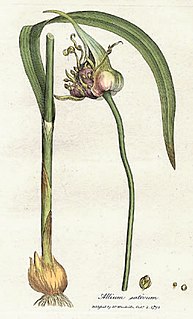
Garlic is a species in the onion genus, Allium. Its close relatives include the onion, shallot, leek, chive, Welsh onion and Chinese onion. It is native to Central Asia and northeastern Iran and has long been a common seasoning worldwide, with a history of several thousand years of human consumption and use. It was known to ancient Egyptians and has been used as both a food flavoring and a traditional medicine. China produces some 80% of the world's supply of garlic.
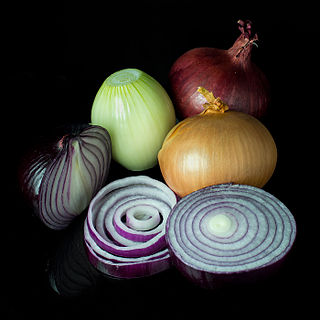
The onion, also known as the bulb onion or common onion, is a vegetable that is the most widely cultivated species of the genus Allium. The shallot is a botanical variety of the onion. Until 2010, the shallot was classified as a separate species.

Scallions are vegetables derived from various species in the genus Allium. Scallions have a milder taste than most onions. Their close relatives include garlic, shallot, leek, chive, and Chinese onions.
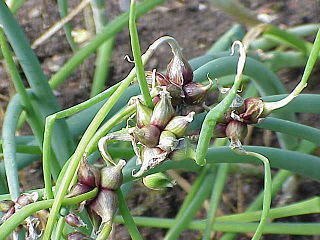
Tree onion, topsetting onions, walking onions, or Egyptian onions, Allium × proliferum, are similar to common onions (A. cepa), but with a cluster of bulblets where a normal onion would have flowers. Genomic evidence has conclusively shown that they are a hybrid of the common onion and the Welsh onion (A. fistulosum). However, some sources may still treat the tree onion as A. cepa var. proliferum or A. cepa Proliferum Group. Tree onion bulblets will sprout and grow while still on the original stalk. They may bend down under the weight of the new growth and take root some distance from the parent plant, giving rise to the name "walking onion." It has been postulated that the name "Egyptian onion" derived from Romani people bringing tree onions to Europe from the Indian subcontinent.

Quercetin is a plant flavonol from the flavonoid group of polyphenols. It is found in many fruits, vegetables, leaves, seeds, and grains; red onions and kale are common foods containing appreciable amounts of quercetin. Quercetin has a bitter flavor and is used as an ingredient in dietary supplements, beverages, and foods.
Tetrahydrothiophene is an organosulfur compound with the formula (CH2)4S. It contains a five-membered ring consisting of four carbon atoms and a sulfur atom. It is the saturated analog of thiophene. It is a volatile, colorless liquid with an intensely unpleasant odor. It is also known as thiophane, thiolane, or THT.
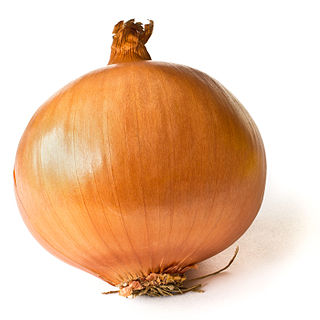
The brown onion or yellow onion is a variety of dry onion with a strong flavour. They have a greenish-white, light yellow, or white inside; its layers of papery skin have a yellow-brown or pale golden colour.

syn-Propanethial S-oxide (C3H6OS), a member of a class of organosulfur compounds known as thiocarbonyl S-oxides (formerly "sulfines"), is a volatile liquid that acts as a lachrymatory agent (triggers tearing and stinging on contact with the eyes). The chemical is released from onions, Allium cepa, as they are sliced. The release is due to the breaking open of the onion cells and their releasing enzymes called alliinases, which then break down amino acid sulfoxides, generating sulfenic acids. A specific sulfenic acid, 1-propenesulfenic acid, formed when onions are cut, is rapidly rearranged by a second enzyme, called the lachrymatory factor synthase or LFS, giving syn-propanethial S-oxide. The gas diffuses through the air and, on contact with the eye, it stimulates sensory neurons creating a stinging, painful sensation. Tears are released from the tear glands to dilute and flush out the irritant. A structurally related lachrymatory compound, syn-butanethial S-oxide, C4H8OS, has been found in another genus Allium plant, Allium siculum.
Leveillula taurica is an obligate fungal pathogen, from the phylum Ascomycota, which causes powdery mildew on onion. This disease prefers warm, dry environments. It is rare in the United States, and is currently restricted to western states. Globally, it is also a minor problem with limited occurrences in the Middle East, Europe, and South America. L. taurica causes powdery mildew of onions, but is also known to infect other allium, solanaceous, and cucurbit species. The disease has appeared in parts of the Middle East, the Mediterranean, and South and North America. Currently, it is not a cause for major concern in the U.S. and throughout the world, as its geographic extent is sparse. In addition, it is relatively easy to control through basic sanitation and reducing water stress.

The leek moth or onion leaf miner is a species of moth of family Acrolepiidae and the genus Acrolepiopsis. The species is native to Europe and Siberia, but is also found in North America, where it is an invasive species. While it was initially recorded in Hawaii, this was actually a misidentification of Acrolepiopsis sapporensis.
Mederma is a topical product used to improve scar appearance. It is a gel based on an onion extract and produced by Merz Pharmaceuticals of Frankfurt, Germany, although it is not sold in Germany. Mederma's marketing claims it can make scars "softer, smoother, and less noticeable". Generic versions are sold under the name cepalin.

Isorhamnetin is an O-methylated flavon-ol from the class of flavonoids. A common food source of this 3'-methoxylated derivative of quercetin and its glucoside conjugates are pungent yellow or red onions, in which it is a minor pigment, quercetin-3,4'-diglucoside and quercetin-4'-glucoside and the aglycone quercetin being the major pigments. Pears, olive oil, wine and tomato sauce are rich in isorhamnetin. Others sources include the spice, herbal medicinal and psychoactive Mexican tarragon (Tagetes lucida), which is described as accumulating isorhamnetin and its 7-O-glucoside derivate. Nopal is also a good source of isorhamnetin, which can be extracted by supercritical fluid extraction assisted by enzymes.

Taxifolin (5,7,3',4'-flavan-on-ol), also known as dihydroquercetin, belongs to the subclass flavanonols in the flavonoids, which in turn is a class of polyphenols.

Quercetin 3,4'-diglucoside is a flavonol glycoside found in onions and in horse chestnut seeds.

Allium is a genus of monocotyledonous flowering plants that includes hundreds of species, including the cultivated onion, garlic, scallion, shallot, leek, and chives. The generic name Allium is the Latin word for garlic, and the type species for the genus is Allium sativum which means "cultivated garlic".
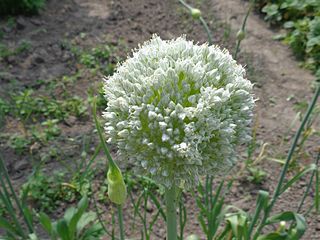
The precise taxonomy of the genus Allium is still poorly understood with incorrect descriptions being widespread. With over 850 species distributed over the Northern hemisphere Allium is the sole genus in the Allieae, one of four tribes of subfamily Allioideae (Amaryllidaceae). New species continue to be described and Allium is both highly variable and one of the largest monocotyledonous genera, but the precise taxonomy of Allium is poorly understood, with incorrect descriptions being widespread. The difficulties arise from the fact that the genus displays considerable polymorphism and has adapted to a wide variety of habitats. Furthermore, traditional classications had been based on homoplasious characteristics. However, the genus has been shown to be monophyletic, containing three major clades, although some proposed subgenera are not. Some progress is being made using molecular phylogenetic methods, and the internal transcribed spacer (ITS) region, including the 5.8S rDNA and the two spacers ITS1 and ITS2, is one of the more commonly used markers in the study of the differentiation of the Allium species.
The onion test is a way of assessing the validity of an argument for a functional role for non-coding DNA, sometimes called "junk DNA". It relates to the paradox that would emerge if the majority of eukaryotic non-coding DNA were assumed to be functional and the difficulty of reconciling that assumption with the diversity in genome sizes among species. The term "onion test" was originally proposed informally in a blog post by T. Ryan Gregory in order to help clarify the debate about junk DNA. The term has been mentioned in newspapers and online media, scientific journal articles, and a textbook. The test is defined as:
The onion test is a simple reality check for anyone who thinks they have come up with a universal function for junk DNA. Whatever your proposed function, ask yourself this question: Can I explain why an onion needs about five times more non-coding DNA for this function than a human?
Leek yellow stripe virus (LYSV) belongs to the genus Potyvirus. It was first detected in leek but also infects garlic and onion worldwide. The virus causes typical yellow stripe symptom on leek. A yield reduction of up to 54% on garlic has been reported. LYSV is transmitted in non-persistent manner by Aphis fabae and Myzus persicae but not by seeds. Its ssRNA genome has one large open reading frame (ORF) that encodes a polyprotein of ca. 10,131 nt and 3,152 amino acids, excluding the poly-(A) tail.













